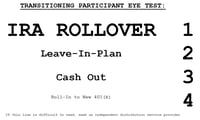 Any day now, the Department of Labor will issue the final version of the long-awaited “Fiduciary Rule” which will redefine the term “fiduciary” under ERISA. Much has been written about the impact on advisors and broker-dealers, given their service models to retirement plans.
Any day now, the Department of Labor will issue the final version of the long-awaited “Fiduciary Rule” which will redefine the term “fiduciary” under ERISA. Much has been written about the impact on advisors and broker-dealers, given their service models to retirement plans.
Another side of the retirement market could see big changes: the handling of distributions for job-changing participants. While a qualified plan distribution might seem like an administrative task, it’s actually a critical transition point, where plan sponsors must carefully consider the information, guidance and assistance that their participants receive, ensuring that it’s both complete and conflict-free.
How the Definition of Investment Advice Will Change
Under the current rules, the DOL uses a five-part test to determine whether a service provider is providing “investment advice” and thus acting in a fiduciary capacity. For the advice to be considered investment advice, the following 5 conditions must be met:
- Advice is given as to the value of an investment or the wisdom of purchasing an investment.
- The advice is delivered on a regular basis, and is
- pursuant to a mutual agreement between the advisor and advisee.
- The advice is individualized, and
- serves as the primary basis for investment decisions.
Under the proposed rule, the five-part test is replaced by a two-part test where the following conditions must be met:
- Advice is given as to the value of an investment or the wisdom of purchasing an investment.
- The service provider acknowledges their fiduciary status (mutual agreement), or the advice is individualized and for consideration in investment decision-making.
Notably absent from the new two-part test is the requirement that the advice be given on an ongoing basis. This has called into question whether one-time “guidance” or assistance given to participants when they change jobs would be considered fiduciary investment advice, under the new rule.
Is Distribution Processing in the DOL’s Crosshairs?
Today, distribution processing is largely perceived as an administrative function, and typically handled by 401(k) recordkeepers. However, this “administrative” function can quickly morph into the delivery of advice, particularly when bias or conflicts of interest are present.
Let’s look at how this process works, and where the fiduciary issues can arise.
When participants change jobs, the options that are available to them for their 401(k) balances with a prior employer typically include:
- Leaving the balance in the prior plan
- Rolling over to their new 401(k)
- Rolling over to an IRA
- Cashing out
Unfortunately, most participants will not be adequately informed of their options. In 2013, the GAO found that participants tended to receive information that was either too generic, or too long and technical, thus leaving them overwhelmed and confused, and unable to understand or compare their distribution options.
To dispel this confusion, participants often go to their company’s benefits website, where they’ll find instructions on how to contact their recordkeeeper for assistance. Many will download a distribution form, prominently featuring their recordkeeper’s toll-free number, with instructions to call and talk to a “retirement service specialist” for assistance. Chances are, most participants will take the easy path, contacting their recordkeeper and speaking with a call center representative. It is this interaction that plan sponsors may want to pay close attention to, post-release of the new fiduciary rule.
Today, when a participant contacts their prior employer’s recordkeeper looking for information and assistance, bias and conflict can arise when:
- Recordkeepers with retail IRA products use this interaction as an opportunity to “harvest” rollovers to their retail IRA products. The 2013 GAO study found that service providers’ call center representatives encouraged rolling 401(k) plan savings into an IRA, even with only minimal knowledge of a caller’s financial situation.
- Recordkeepers' distribution departments can’t or won’t process plan-to-plan transfers (rollovers to the new 401(k) plan).
- Recordkeepers can’t or won’t adequately discourage participant cashout behavior. If the plan balance is sufficiently low, recordkeepers may have little incentive to assist the participant with any options that preserve their qualified retirement savings.
If the service center representative has a bias towards a rollover to their retail IRA, towards having the participant leave the balance behind, can’t process a plan-to-plan transfer, or won’t adequately discourage cashouts, then what kind of objective counsel will that participant receive?
Impact Changes May Have on the 401(k) Industry: Participant Transition Management
If the interaction described above is deemed fiduciary investment advice under the new rule, plan sponsors will need to carefully evaluate & monitor the distribution decision information and guidance that’s delivered to participants, at transition. Recordkeepers will be required to effectively support a distribution process (including call center scripts) that accommodates the new reality.
Alternatively, sponsors may want more assurance that their participants are receiving objective, non-biased, non-conflicted guidance on distributions. This need will give rise to a new, specialized “participant transition management” service provider that is bias- and conflict-free -- with the experience, systems and scale to provide effective guidance and assistance for all four distribution options that a participant must consider.
Rather than invest in developing their own capabilities, many recordkeepers may choose to outsource this function, just as they do today with automatic rollovers/mandatory distributions. As the Economic Growth and Tax Relief Reconciliation Act of 2001 (EGTRRA) gave birth to a new safe harbor IRA industry, Labor’s Fiduciary Rule may also give rise to a highly specialized participant transition management industry. Ironically, the safe harbor IRA may be the vehicle providing small balance portability (Auto Portability) as part of outsourced participant transition management.
